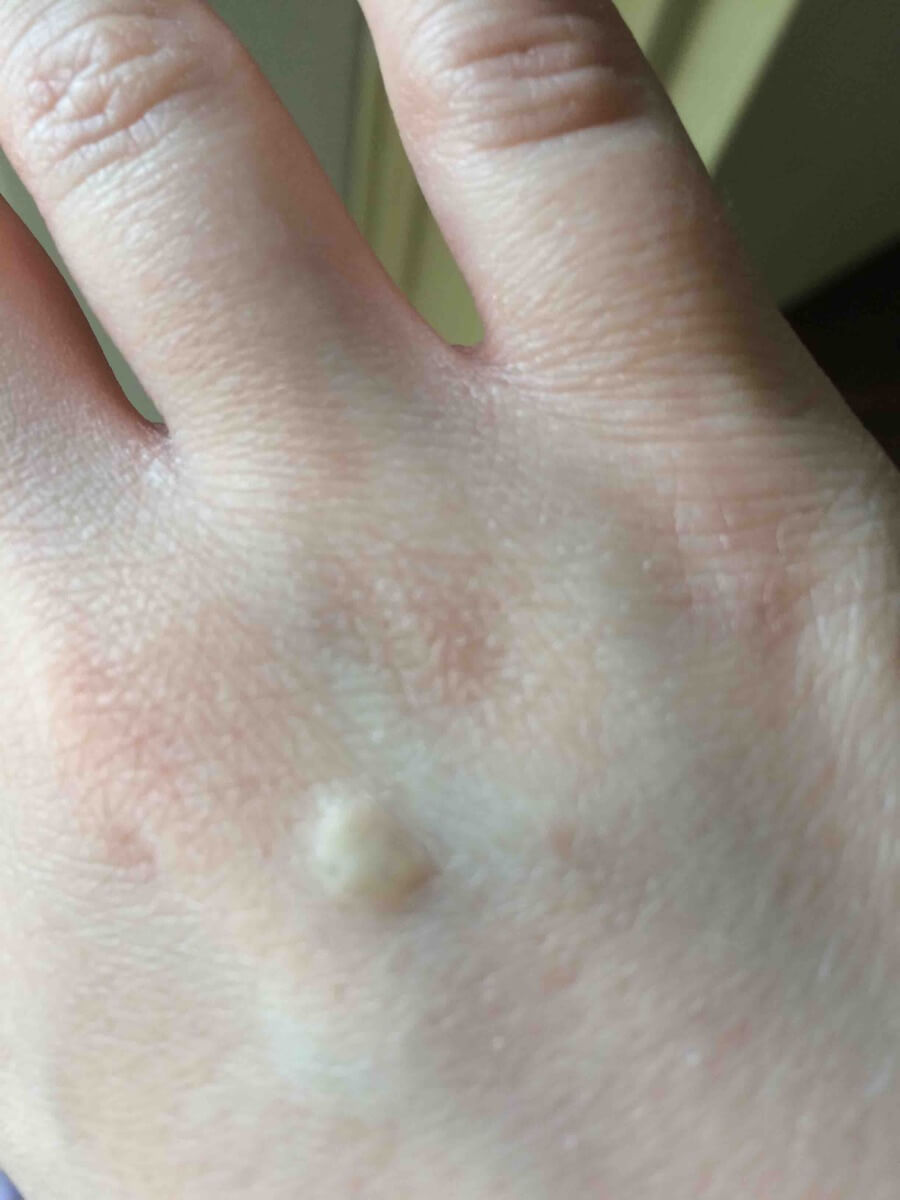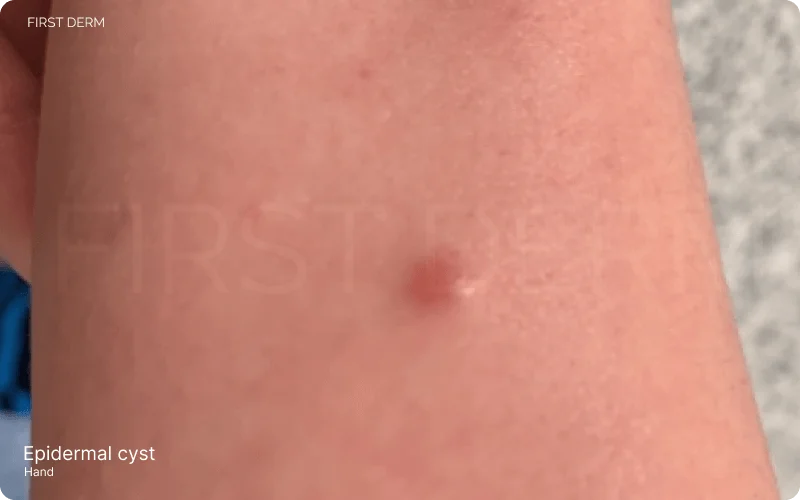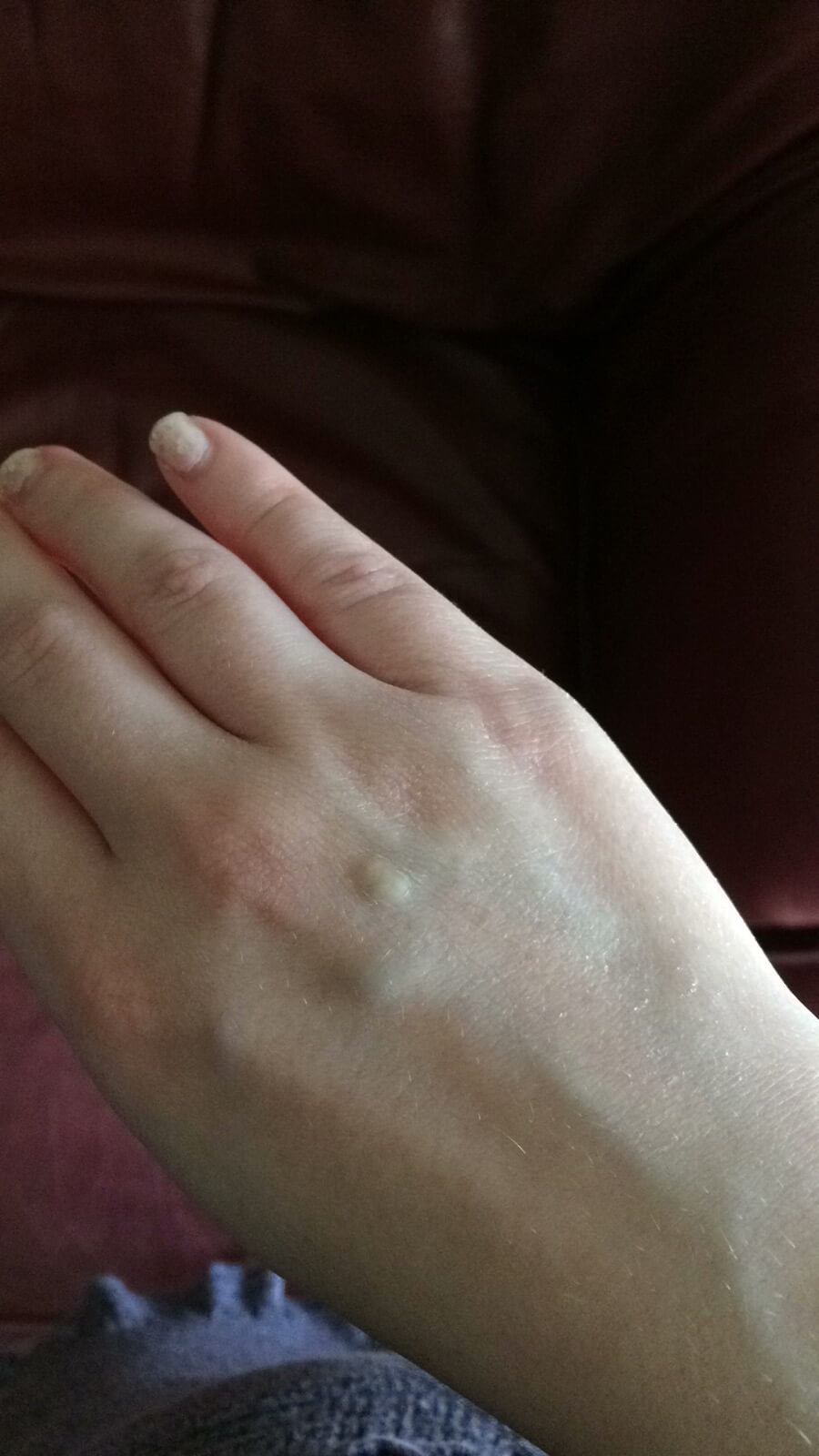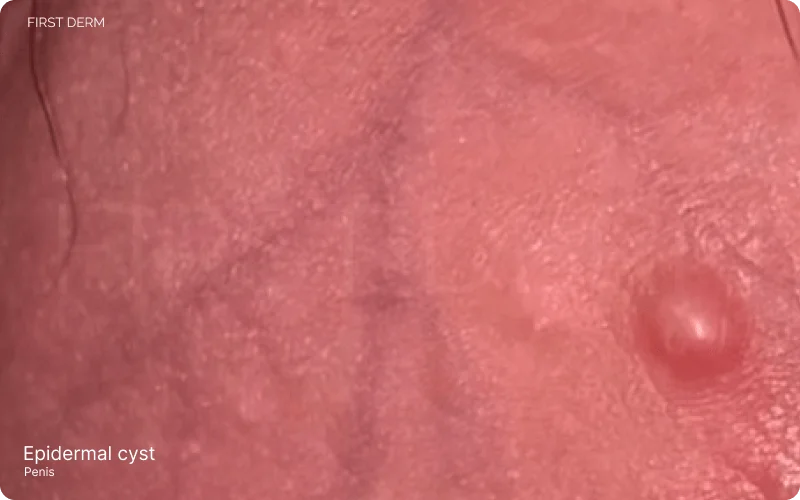Epidermal cyst – clogged sebaceous gland
Medically reviewed by The Dermatologists and written by Dr. Alexander Börve
Common
Very
- Adults
- Often self-diagnosable
- Symptoms: Raised, cyst that moves from the underlying texture.
- Color: Skin
- Location: On the face, neck, chest, back, shoulders and upper arms
- Treatment: None. Surgery
ICD-10: L 72.1
Related Blog Posts:

Epidermal cyst on a hand, resulting from a clogged sebaceous gland, showcasing the typical raised, rounded appearance of this skin condition
Epidermal cysts occur most commonly on the face, neck, extremities, trunk and scrotum. Most cysts arise in adult life. They are more than twice as common in men as in women. Cysts present as one or more flesh–colored to yellowish, adherent, firm, round nodules of variable size. A central pore or punctum may be present. Keratinous contents are soft, cheese-like and malodorous. Cysts are usually diagnosed clinically as they have typical characteristics. Asymptomatic epidermal cysts do not need to be treated. In most cases, attempt to remove only the contents of a cyst is followed by recurrence.
In some cases it can be in combination with an inflammation, and the cyst can swell and be painful to the touch. In rare cases they can become infected and an abscess forms. They are rare before puberty.
Is this what you have? Try our FREE Skin Image Search today and get peace of mind
Symptoms

Close-up view of a 3-5mm flesh-colored epidermal cyst on a hand, illustrating a common presentation of this benign skin anomaly
Epidermal cysts can occur, because of family history, after surgery, reaction to skin damage, genetic conditions, but most often if there is an underlying skin disease, such as hyperhyidrosis and acne increases the risk.

Epidermal cyst – clogged sebaceous gland right hand
They are often broad and slightly uneven a rounded resistance that is clearly soft to the touch and elastic in texture and are free to slide around from underneath. They are not usually sore if there is no inflammation or and infection. The size can vary from a few mm to several centimeters and fluctuate in size
Try our artificial intelligence algorithm for FREE to screen your skin
Epidermal cysts on Genitals

Epidermal cyst on penis present as a tiny bump at the base of penile shaft
Epidermal cysts can develop in the genital regions of both men and women. These benign skin formations can sometimes be confused with symptoms of sexually transmitted diseases (STDs), primarily due to their sensitive location. We delve into the distinguishing features of epidermal cysts, such as their size, shape, and texture, and how they differ from typical STD manifestations.
The critical role of professional medical assessment is highlighted to ensure accurate identification. Misidentifying these cysts as STDs can lead to unnecessary anxiety and inappropriate treatment. Therefore, understanding when to consult a healthcare professional for diagnosis and advice on managing or treating epidermal cysts is essential for appropriate care and peace of mind.
Differential Diagnosis
Furuncle is a deeper infection that involves the hair follicle with the involvement of the dermis and Subcutis.
Lipoma. Benign, subcutaneous, sometimes intramuscularly located fat knot. Often a slow growth. Usually sits a bit deeper than an epidermal cyst. A superficial lipoma is usually surrounded by a capsule and therefore not movable from surrounding tissue and they usually do not fluctuate in size.
Angio lipoma. Benign subcutaneous change. Rarer. Often multiple and hereditary occurrence. Usually occurs on forearms and breasts at a young age. May be pain to the touch and body strain.
Fibroma. Small, soft connective tissue knuta. Rounded, tab-shaped E T. C. Occurs from the age of 30 and upwards, often on the neck or face. Most are skin colored, more rarely pigmented.
Dermoid cyst. Innate, appears almost always in childhood, not seldom already at birth. Can contain shifting structures at different stages of development, such as teeth and hair. The most common localization are the eyebrows.
Lymphoma. One or more magnified (> 1.5 cm in diameter), lymph glands.
Try our artificial intelligence algorithm for FREE to screen your skin
Should I seek medical care?
They are benign. Seek medical care if they grow, get infected or are painful. Otherwise it is just of cosmetic concern.
Epidermoid Cyst Treatment
In case of more pronounced inflammation/infection, the treatment is surgical; Incision and drainage. Whether it is cosmetic or otherwise disturbing and recurring it is surgically treated. It is important that the whole capsule is extracted.
Antibiotic treatment is very rarely topical; In principle only at more pronounced infected cysts
Try our artificial intelligence algorithm for FREE to screen your skin
Updated on January 05, 2024
References
- Hoang VT, Trinh CT, Nguyen CH, Chansomphou V, Chansomphou V, Tran TTT. Overview of Epidermoid Cyst. Eur J Radiol Open. 2019;6. Published 2019 Sep 5. doi:10.1016/j.ejro.2019.08.003. Available from: https://www.ejropen.com/article/S2352-0477(19)30040-1/fulltext.
- Nakajima K, Korekawa A, Nakano H, Sawamura D. Subcutaneous Dermoid Cysts on the Eyebrow and Neck. Pediatr Dermatol. 2019. Published 2019 Aug 14. doi:10.1111/pde.13976. Available from: https://onlinelibrary.wiley.com/doi/abs/10.1111/pde.13976.
Ask a Dermatologist
Anonymous, fast and secure!

The Specialist doctor from the University Hospital in Gothenburg, alumnus UC Berkeley. My doctoral dissertation is about Digital Health and I have published 5 scientific articles in teledermatology and artificial intelligence and others.

